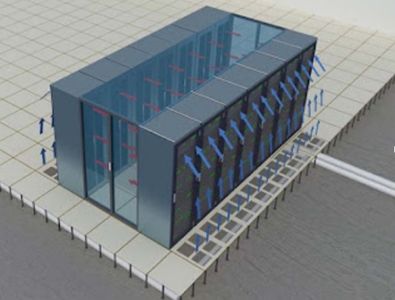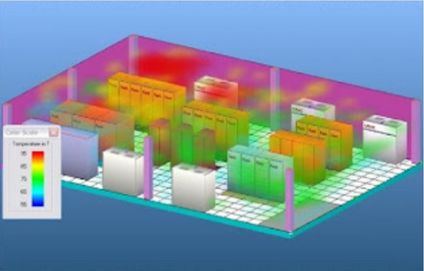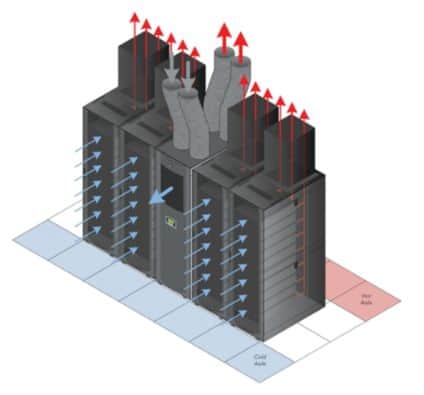Choosing the right location and building materials for a data center is an essential aspect of green data center design. However, another key factor to consider is the role of cooling.
Today, the primary concern or problem is our survival on earth without harming our environment or living an eco-friendly life. Green computing is the easiest way to reduce carbon gas emissions produced through computers and computer resources in our day-to-day settings like data centers, hardware equipment, software processing, etc.
Green Data Center Design with Efficient Cooling
Green computing works to develop the efficiency of the computer and its parts, namely processor speed, ram speed, memory, etc., with less power consumption.
Several major companies are using green computing to reduce power consumption and cost to increase profit by reducing energy costs through high efficiency.
It is very crucial for the development of a safe environment. Statistics show that a big data center can utilize energy equal to a tiny city.
Optimizing the cooling system in the data center or section can reduce power consumption significantly. This article will explain the development of designing a cooling section for data centers.
Software is also a significant thing in the computer. Software is also affecting our environment with the speed form of work. If some work doing in software such as Microsoft word for making a word file, estimate that we are making only five pages of word file in MS word, but they take more than 1 hour.
Due to slow software, the actual time is less than 25 minutes to complete this work. So, the computer can work more than 60 minutes unnecessarily. Green computing is used in the design, architecture, and high-speed access software.
Need for Green Data Centers
The basic working concept of Green data center design is based on the working of computers and their resources having better:
- Efficiency. A combination of smart HVAC controls, liquid cooling, or a hybrid center design featuring a chilled water system can achieve energy efficient cooling.
- High speed of access. You should pay special attention to the operation of carrier-neutral data centers. In this case, content providers (multimedia companies and standard hosting) will get a high level of service that meets their standards.
- Low power consumption. We must address the energy consumption of the IT infrastructure. Otherwise, it will have a negative impact on the environment and on companies that depend on clean water.
- Less size.
Green Data Center Design & Operation
Right-sizing the data center system to the load, utilizing efficient physical infrastructure devices, & designing an energy-efficient system are all techniques that help to reduce energy costs.
A successful strategy for addressing the challenge of data center energy management requires a multi-pronged approach that should get enforced throughout the data center’s lifecycle.
System design
In data centers, system design has a much more significant effect on electrical consumption than individual devices’ efficiency. Two data centers of the same devices may have considerably separate electrical bills. Due to this reason, system design is even more significant than the selection of power & cooling devices in determining the data center’s efficiency.
Floor layout
Floor layout significantly affects the efficiency of the Air Conditioning system. Best arrangements involve hot or cold aisle configurations with appropriate air conditioner locations.
This floor layout approach’s primary Green data center design focus is cool & warm air separation.
Proper configuration of server software
When customizing servers, many data center managers are not careful about configuring the power-related software. Power-economizer modes should always get selected to ensure a more efficient server operation.
Location of vented floor tiles
In a regular data center, many vented tiles are placed in incorrect locations, or an insufficient/excessive number of vented tiles gets installed.
By using Computational Fluid Dynamics in the data center environment, the designer can optimize the cool air flow by “tuning” floor tiles in the following ways:
- By differing locations and by regulating the % of vents that are open at the given time
- By optimizing Computer Room Air Conditioning unit locations.
How to Improve Green Data Centre Design Cooling Efficiency?
Today, data center managers need to monitor energy costs closely. As per the Uptime Institute’s 2011 Data Center Survey, 97% of respondents said decreasing energy use was either “somewhat” or “very” important, & 87% said the main motivation was cost reduction.
Because the servers and other equipment will generate a lot of heat, the cooling system should be based on the amount of heat that will be generated by the servers and other equipment within the facility.
The amount of power required for cooling depends on the amount of heat produced by each server, as well as the efficiency of the cooling system.
When designing your data center, you need to consider several factors:
- The type and number of servers that you will use in your facility;
- How many racks will be used?;
- The size of each rack?;
- Whether you plan to use raised floors or not;
- The location of your data center (e.g., whether it’s indoors or outdoors); and
- What kind of building materials do you want (e.g., concrete vs steel)?
An Uptime Institute study also mentioned that up to 70% of data center energy usage is for cooling & air handling, so increasing cooling efficiency is vital to decreasing costs. Start with the low-hanging fruit. You’ll get to know how much you can save with a few simple steps.
Implement Hot/Cold Aisle
You don’t need to place your data center at meat locker temperatures. Instead of it, concentrate on removing hot air from the room before it recirculates. Separating hot & cold air is the key to cooling efficiency.
Begin by arranging racks in rows so the fronts face each other in cold aisles & the backs face each other in hot aisles. That prevents servers from drawing hot air from servers in the adjacent row. According to TDI study Data Centers, hot/cold aisle configurations can reduce energy use by up to 20%.
Install Blanking Panels
Shutting off unused rack spaces isn’t just cosmetic. It forces cold air through your servers & prevents hot air from recirculating the enclosure. If you look, you can discover blanking panels that snap into place without tools, saving primary installation time.
Organize Cables
Tangled cables block airflow. These cables prevent efficient cold air distribution under raised floors & cause heat to increase inside enclosures. In raised-floor environments, move cabling to above cable managers. Inside chambers, use high-capacity cable managers to organize patch cables.
.Read More: Six Steps to Improve Data Center Cooling Efficiency.
Replace Inefficient UPS Systems
Removing excessive heat sources helps cool the room. Replace traditional online UPS systems with energy-saving models to increase efficiency & decrease heat output, primarily where redundant UPS systems operate below total capacity.
Use Close-Coupled Cooling
Gartner Group found that close-coupled cooling increases efficiency more than the traditional perimeter or raised floor systems. Close-coupled cooling permits you to focus cooling where it’s needed most without lowering the temperature of the entire room. The modular nature of close-coupled cooling also enables data center managers to reconfigure cooling to handle new equipment quickly or overheating racks.
Several companies offer self-contained close-coupled cooling solutions that IT staff can place without expensive contractors, plumbing, piping, special ductwork, floor drains, water tanks, or extra parts.
Isolate and Remove Hot Air
Combining a hot-aisle/cold aisle configuration with thermal duct rack enclosures & close-coupled, row-based AC units creates a highly efficient data center cooling solution. Thermal duct rack enclosures route hot air via an overhead duct to the HVAC or CRAC return air stream.
They isolate hot air so it can’t rerelease in the room. Convection forces hot air up via the duct, like a chimney, & positive pressure in the chamber and negative pressure in the plenum cause the airflow to rise.
Conclusion:
Datacenter cooling is an application of separating hot air from cold air. Too much hot air spreading in a data center can cause equipment to overheat and malfunction. A facility that can do this reliably, cost-effectively, and with consistent monitoring is on the right track to cooling efficiency.
However, other techniques are becoming more commonly adopted, and the use of direct evaporative cooling techniques has been used extensively in the past.
Data center design professionals should consider adopting the following techniques in their green data center designs:
- Adopt a shell-side economizer solution rather than a free cooling solution (if direct evaporative cooling is not feasible).
- Incorporate at least one hot aisle containment system into a green data center design.
- Use thermal mass/heat storage or adiabatic systems to temper chiller plant load.
- Create a balanced design between heat generating equipment and heat rejection equipment, within a given row in the data center.
If you’re interested in conserving energy, your data center may be one of the easiest places to start. By implementing advanced cooling technologies, you can reduce your cooling costs while also reducing wasted energy and making your company more environmentally friendly overall.
If that sounds like a win-win situation to you, then it’s time to take the first step—getting started on green data center design. The key takeaway from the article is that minimizing heating and cooling requirements will decrease your power consumption.




